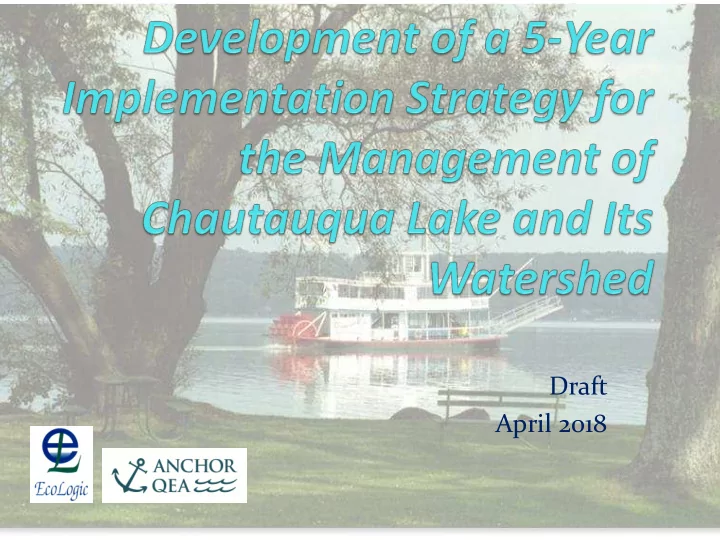

Draft April 2018
Presentation Outline Challenge Approach Multi-criteria analysis tool Application of the tool Implications for managers
Presentation Outline Challenge Approach Multi-criteria analysis tool Application of the tool Implications for managers
Alliance Mission Knowledge of Stakeholder Lake and desires and watershed concerns management Funding Opportunities Priority Actions
Presentation Outline Challenge Approach Multi-criteria analysis tool Application of the tool Implications for managers
Local Voices: Priorities Stakeholders Represented Focus Group (# participants) Municipalities (11) 1 Agriculture and Parks (6) 2 Business and Tourism, including realtors (11) 3 Scientists (8) 4 Chautauqua Lake Association (9) 5 Chautauqua Lake Partnership (4) 6 Conservation and Environmental Groups (9) 7 Foundations (12) 8 Chautauqua Institution (5) 9
Local Voices: Priorities Human health concerns Protect recreational access- economic driver Need for collaboration and coordination Fear that lake has reached a tipping point Need to document and communicate progress
Presentation Outline Challenge Approach Multi-criteria analysis tool Application of the tool Implications for managers
Multi-criteria Analysis (MCA) Set up an evaluation matrix (project alternatives and evaluation criteria) Assign weighting factors to each criterion Indicates relative importance compared with other criteria Assign scores for ‘desirability’ under each criterion for each alternative
Criteria Common Watershed In-lake Scoring
Criteria: All Projects Consistent with plans, strategies, or successes Broadly supported Costs are understood Magnitude of costs Potential for outside funding O&M requirements Plan to measure and report effectiveness
Criteria: In-lake Projects Protective of human health Protective of ecosystem health Longevity of effectiveness Reduce nutrients in ecosystem Manage invasive species Enhance recreational uses
Criteria: Watershed Projects Reduction in nutrient loading Reduction in sediment loading Resilience
Weighting Factors 20 Environmental 50 Social Economic 30
Scoring Scaled as 0,3,6,9 Specific guidelines Potential role for scientific advisors for technical scoring
Example of Watershed Environmental Criteria Criteria Scoring Values 0: No impact on nutrient loading Reduction in nutrient 3: Plan addresses a source estimated to contribute loading <10% of total nonpoint source TP load per TMDL (septic, streambanks) (weight: 50) 6: Plan addresses a source estimated to contribute 10-25% of total nonpoint source TP load per TMDL (stormwater, forest practices) 9: Plan addresses a source estimated to contribute >25% of total nonpoint source TP load per TMDL (agriculture)
Example of General Social Criteria Criteria Scoring Values 0: Only one organization involved Commitment to stakeholder 3: Multiple organizations involved, specific roles collaboration undefined 6: Multiple collaborators, with project role and (weight: 30) inputs (e.g., staff time, equipment/materials) defined for each 9: Multiple collaborators, with expected project outputs (e.g., outreach products, data/information, nutrient reduction actions) defined for each
Example of In-Lake Environmental Criteria Criteria Scoring Values 0: Probable toxic or carcinogenic effect Protective of human health 3: Lack of scientific consensus regarding toxic or carcinogenic effect (weight of evidence points (weight: 50) to low risk) 6: Classified as “not likely” to be toxic or carcinogenic 9: Scientific consensus of no harmful human health impacts
Example of General Environmental Criteria Criteria Scoring Values 0: Proposed action inconsistent with existing Consistency plans or strategies with existing plans and 3: Proposed action is not listed in plans or strategies but is consistent with objectives strategies and/or 6: Proposed action is listed in an existing plan or strategy consideration of emerging 9: Proposed action is listed as approvable for solutions specific application in an existing plan or strategy, and has been demonstrated to hold promise based on research or use in other (weight: 40) lakes/watersheds
Presentation Outline Challenge Approach Application of the tool Implications for managers
Application Define the project Document assumptions Determine whether to include all criteria Assign scores for criteria Matrix math to multiply weights; add and total Use totals as a guide to implementation Build partnerships with land owners Justify and request non-local cost sharing
Demonstration of Tool Draft Chautauqua MCA Tool_2018-04-09.xlsx
Presentation Outline Challenge Approach Multi-criteria analysis tool Application of the tool Implications for managers
Balancing Cause and Symptoms Figure 5-1 Resource Allocation, 2018-2022 Watershed In-Lake Monitoring 2018 30% 50% 20% 2019 40% 40% 20% 2020 50% 30% 20% 2021 60% 20% 20% 2022 60% 20% 20%
Governor’s HAB Initiative Invest $65 million NYS funds to define and implement solutions to cyanobacterial blooms 12 priority lakes, including Chautauqua Lake Action Plans due end of May 2018 Opportunity for progress
5-Year Strategy Outlines watershed initiatives, in-lake projects, and research & monitoring to address data gaps Ran top recommendations of the watershed management plan through the tool Recommendations will be affected by HAB action plans and funding
Recommend
More recommend